Rosemary herb nutrition facts
Charmingly fragrant rosemary herb is the perfect potherb to have in your kitchen garden. It is one of the recognized herbs for its note-worthy health benefiting phyto-nutrients, anti-oxidants, and essential acids.
Rosemary belongs within the family of Lamiaceae, of the genus, Rosmarinus. Its botanical name is Rosmarinus officinalis.
The herb is thought to be originated in the Mediterranean region as a wild, strewing evergreen perennial shrub. Today, it is grown in nearly all parts of the Mediterranean region and Asia minor as an important culinary herb.
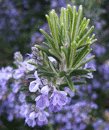 |
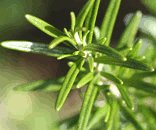 |
Light-blue color rosemary flowers.
|
Rosmarinus officinalis Note needle like narrow, pointed leaves. |
Rosemary flourishes in well-drained, alkaline soil. It prefers sunny condition but at the same time needs shelter from gusty winds. The plant reaches about 1.5-3 meters in height. Its bushy stems and downy young shoots are covered with about 1 inch long, narrow, needle-like aromatic leaves; dark green above and grayish underneath. The plant bears short racemes of small sea-blue flowers appearing in early summer.
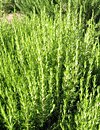 |
| Rosemary herb. Note for narrow, dark green leaves. |
The plant parts; flowers and leaves have fragrance that is pungently aromatic and somewhat camphoraceous (camphor-like).
Apart from culinary and medicinal purpose, traditionally rosemary shoots, flowers and leaves are being used in festivals and wedding ceremonies to decorate banquet halls as incense to ward off bad influences.
Health benefits of Rosemary herb
-
Rosemary leaves contain certain phyto-chemical (plant derived) compounds that are known to have disease preventing and health promoting properties.
-
The herb parts, especially flower tops contain phenolic anti-oxidant rosmarinic acid as well as numerous health benefiting volatile essential oils such as cineol, camphene, borneol, bornyl acetate, a-pinene, etc. These compounds are known to have rubefacient (counterirritant), anti-inflammatory, anti-allergic, anti-fungal and anti-septic properties.
-
Rosemary leaves provide just 131 calories per 100 g and contain no cholesterol. Apart from nutrients, this humble herb contains many noteworthy non-nutrient components such as dietary fiber (37% of RDA).
-
The herb is exceptionally rich in many B-complex groups of vitamin, such as folic acid, pantothenic acid,pyridoxine, riboflavin. It is one of the herbs containing high levels of folates; providing about 109 µg per 100 g (about 27% of RDA). Folates are important in DNA synthesis and when given during the peri-conception period can help prevent neural tube defects in the newborn babies.
-
Rosemary herb carry very good amounts of vitamin A, 2924 IU per 100 g; about 97% of RDA. A few leaves a day in the diet, would contribute enough of this vitamin. Vitamin A is known to have antioxidant properties and is essential for vision. It is also required for maintaining healthy mucusa and skin. Consumption of natural foods rich in vitamin A is known to help the body protect from lung and oral cavity cancers.
-
Fresh rosemary leaves are a good source of antioxidant vitamin; vitamin-C containing about 22 mg per 100 g, about 37% of RDA. The vitamin is required for the collagen synthesis in the body. Collagen is the main structural protein in the body required for maintaining the integrity of blood vessels, skin, organs, and bones. Regular consumption of foods rich in vitamin C helps the body protect from scurvy; develop resistance against infectious agents (boosts immunity) and help scavenge harmful, pro-inflammatory free radicals from the body.
-
Rosemary herb parts, whether fresh or dried, are rich source of minerals like potassium, calcium, iron, manganese, copper, and magnesium. Potassium is an important component of cell and body fluids, which helps control heart rate and blood pressure. Manganese is used by the body as a co-factor for the antioxidant enzyme, superoxide dismutase.
-
This herb is an excellent source of iron, contains 6.65 mg/100 g of fresh leaves (about 83% of RDA). Iron, being a component of hemoglobin inside the red blood cells, determines the oxygen-carrying capacity of the blood.
Selection and storage
Rosemary is generally grown as a garden herb so that its fresh leaves can readily be available for use.
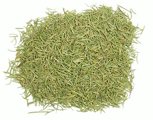 |
Dried rosemary herb leaves.
|
If you need to buy from the herb store, choose fresh rosemary over the dry form of the herb since it is superior in quality and has a subtle flavor. Dried rosemary is stronger and quite pungent in flavor, favored particularly in savory meat dishes. Fresh leaves should feature deep green leaves, free from spots or yellowing.
Fresh rosemary herb should be stored in the refrigerator inside plastic bags. Dried rosemary should be kept in an airtight container and placed in a cool, dark, and dry place where it will keep fresh for several months.
Culinary uses
Wash fresh leaves in cold running water or rinse for few minutes to remove any dirt or pesticide residues. In order to keep the fragrance and flavor intact, the herb is generally added to cooking recipes at the last moments, since prolonged cooking would result in the evaporation of its essential oils.
Here are some serving tips:
-
Fresh or dried rosemary leaves are part of Mediterranean cooking, employd in the preparation of variety of recipes.
-
The herb is used to flavor in salads, soups, baked vegetables, and meat dishes.
-
Rosemary goes well with tomatoes, aubergine, potato, zucchinis (courgettes). Finely chopped fresh leaves are used in the preparation of delicious sautéed rosemary potatoes.
-
Rosemary tea is a popular flavor drink in Mediterranean region.
Medicinal uses of Rosemary
-
Rosmarinic acid, a natural polyphenolic antioxidant found in rosemary, has been found to have anti-bacterial, anti-inflammatory, and anti-oxidant functions. Apart from the rosemary, other popular herbs like Sage,peppermint, oregano, thyme herbs also contain appreciable levels of rosmarinic acid.
-
Rosemary oil which is distilled from the flowering tops contains volatile essential oil such as camphene, cineol, borneol, bornyl acetate and other esters. These compounds are known to have tonic, astringent, diaphoretic, and stimulant properties.
-
Its herbal oil is also being used externally as a rubefacient to soothe painful ailments in gout, rheumatism and neuralgic conditions.
-
Rosemary herb extractions when applied over the scalp known to stimulate the hair-bulbs and help prevent premature baldness. It forms an effectual remedy for the prevention of scurf and dandruff.
-
Rosemary tea is a natural remedy for nervous headache, colds, and depression. (Medical disclaimer).
Safety profile
Rosemary herb may cause abortion in pregnant woman when consumed in large amounts. Further, in some rare cases, rosemary oil products may cause allergic skin reactions. In toxic doses, rosemary has been found to cause kidney dysfunction, and might exacerbate existing neurological conditions like epilepsy, neuroses, etc. (Medical disclaimer).
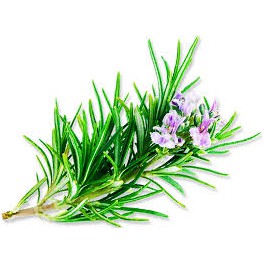 Maximize
Maximize












































